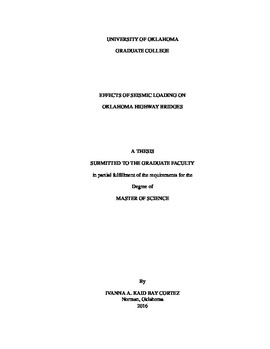| dc.description.abstract | Since 2006, the number of magnitude (M) 3.0 and larger earthquakes occurring in Oklahoma
has increased dramatically. Large magnitude (> 5:0) events have caused damage
to residential structures, which raises a concern about the potential for damage to Oklahoma’s
highway bridges and their components. The purpose of this study is to assess
the seismic response of the most common bridge class in Oklahoma and evaluate its
potential for damage. This is accomplished by considering the Oklahoma Department
of Transportation’s on-system bridge inventory and determining the most typical bridge
class — a 3-span prestressed concrete girder bridge. A representative bridge was modeled
in detail using nonlinear finite elements and a series of transient analyses were
performed to assess its performance under actual Oklahoma ground motions. A suite of
27 bidirectional ground motions from the September 3, 2016 M 5.8 Pawnee Earthquake
(the largest event to date) were used for the transient analysis.
Transient time-history analyses were performed and responses such as bearing deflection
and column curvature were recorded and presented. Small, linear bearing deflections
and column curvatures were observed for the measured ground motions. To
assess the response of the typical highway bridge under higher intensity ground motions,
an incremental dynamic analysis was performed. The measured ground motions
from seismic station GS.OK005 was incrementally scaled to AASHTO design levels
and higher. At the design 1-second spectral acceleration S 1 = 0.10g, larger bearing
deflections and column curvatures were predicted, including closing of the gap in the elastomeric bearings and engagement of the anchor bolts. The ground mtoin was further
scaled to 50% higher than the design level (S 1 = 0.15g), which corresponds to 75%
of ground-motion predictions near the epicenter per ShakeMap. At this ground-motion
intensity, bearing deflections and column curvatures were disproportionately larger than
at design level due to nonlinear e ects such as the yielding of the steel and sliding of the
expansion type bearings. A maximum column curvature of 82% of the yield curvature
was observed. For the measured ground motions and up to 1.5 times the design level,
no damage was predicted. However, damage may occur at observed intensities closer
to the epicenter. | en_US |
